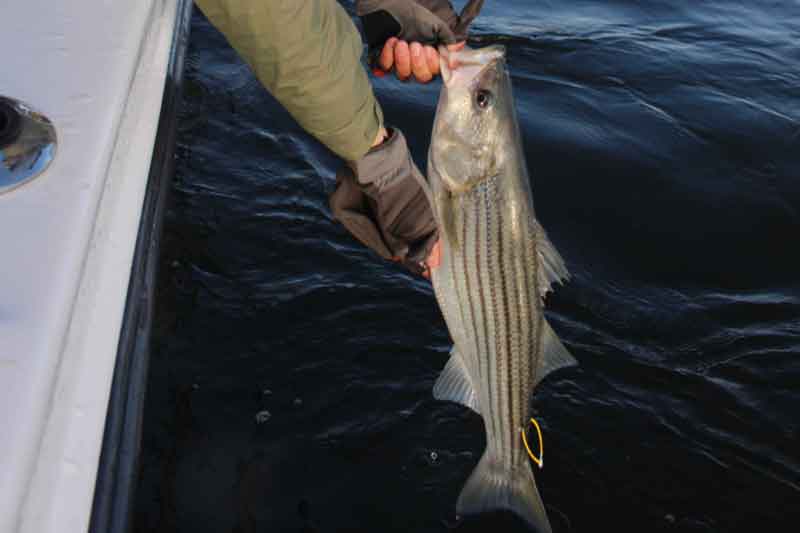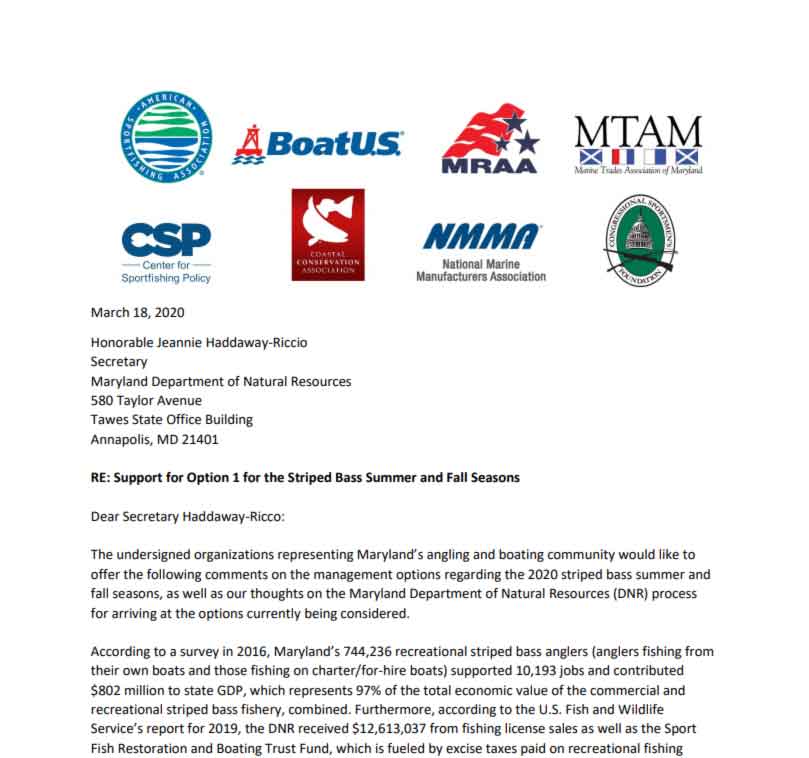Welcome back to FishTalk, folks, and I hope you’re as thrilled as I am to see spring arrive and the Chesapeake and Mid-Atlantic waters come alive for the new season. Yet today I also have to ask you for your forgiveness, as I worry that I may come off a bit strong here. But unfortunately, there’s no polite way to say this: When it comes to striped bass, we recreational anglers and the businesses that support anglers in Maryland just got screwed.

On the whole, anglers are willing and happy to support conservation measures that help the fishery. But they should be fair and equitable among the different stakeholders, and they should actually be intended to help the striped bass populations recover. Unfortunately, the 2020 regulations accomplish neither. A few salient bullet points illustrate this:
- After the Atlantic States Marine Fisheries Commission recommended an equitable reduction in commercial and recreational catch, and public comment was in favor of an equitable reduction, the state decided instead to reduce commercial fishing catch by 1.8 percent and cut the recreational catch by approximately 20 percent.
- After public comment was overwhelmingly against eliminating pre-season catch-and-release fishing, pre-season catch-and-release fishing was eliminated.
- Pre-season catch-and-release fishing was eliminated to net a fallacious “reduction in removals” (how many fish we kill in one way or another) based on a nine-percent catch-and-release mortality rate (how many fish die after being caught and released), even though Maryland’s own spring catch-and-release study shows a release mortality rate between five and six times lower (1.6 percent).
- Pre-season catch-and-release fishing effort estimates from MRIP, used in this decision-making process, claimed 600,000 fish caught in March and April of 2017, which averages out to 10,000 fish a day for 60 days (16 fish per minute of daylight). Even if we assume that the weather allowed for fishing on the open Bay every single day of March and April (which it obviously does not), it’s utterly ludicrous to assert that enough people go catch-and-release striper fishing in the state during the pre-season period to actually handle this many fish. It is even more ludicrous to base management policy decisions on such a blatantly ridiculous figure.
- After public comment was overwhelmingly for an equitable summer/fall limit of one fish per person per day for both recreational and charter boat anglers (1252 comments versus 352) with the season remaining open all summer, charter boat anglers were awarded a two fish per day limit while all other recreational anglers were limited to one a day — and were further penalized by losing almost three weeks of season, to allow for the larger charter catch.
- The Maryland DNR, on its website, and in public meetings, claimed that the recreational summer closure was “in an effort to reduce dead discards,” while failing to mention that no more or less fish would be killed regardless of the closure — because the accounting for estimated dead discards was simply shifted from non-charter recreational anglers to the charter angler’s column. The DNR then sent out multiple press releases omitting important information, causing great confusion among the public.
These facts have made three problems painfully clear: the striped bass fishery in Maryland is not being managed for the good of the fishery; the public’s will is being ignored; and very confusing and rather disingenuous information has been communicated to the public on multiple occasions.

One other thing that’s clear is that these problems are only made possible because of a lack of solid, reliable science on the effect of recreational fishing on striped bass in the Chesapeake Bay, particularly when it comes to release mortality. While the powers that be may feel free to ignore the will of the people, by law they must take validated science into account. Until recently, I thought this lack of science was understandable. After all, it’s impossible to really know just how many fish die when you throw them back, right?
Turns out, that’s not the case. In 2016 and 2018 studies were performed on cod (Estimating and Mitigating the Discard Mortality of Atlantic Cod in the Gulf of Maine Recreational Rod and Reel Fishery) and haddock (Fishery-Scale Discard Mortality Estimate for Haddock in the Gulf of Maine Recreational Fishery) in the Gulf of Maine, which nailed down catch and release mortality including variables like temperature, depth, fight and handling times, fish size, hook location, and more. New tech is the ticket, and it’s called “acoustic telemetry.” Here’s the simplified version: using the same tech that tracks your vehicle when it goes through an E-Zpass toll booth, fish are tagged with pingers (your E-Zpass). Ping-receivers (the toll booths) are planted in the water to overlap their coverage throughout a large area. Scientists can then look at all the ping returns and see the depths the fish go to over time. Fish that are alive move, so when a fish goes to one specific depth and stays there permanently, the scientists know that it’s died. And since they know which pinger is which fish, they can tell when X number caught in Y temperature have died, X caught with Y hook location have died, etc.
Obviously, budgets are strained these days. So, how painful is the cost? I asked one of the scientists responsible for the cod and haddock studies, Connor Capizzano of the Marine Science Center University of New England, this very question. He said “it was a couple hundred thousand dollars for the equipment.” We could do a similar study in that financial ballpark, or according to experts I talked with here on the Bay, initiate a comprehensive, multi-location, two-year study in the Chesapeake and nail down the solid science on striper mortality we need for somewhere in the neighborhood of $400,000 to $500,000. Considering that recreational angling for striped bass fishery supports over 10,000 jobs and contributes over $800 million to the state’s GDP (2016 numbers), this seems like a small price to pay to keep the fishery healthy, and keep recreational anglers fishing.
Why hasn’t a study like this been performed in the Chesapeake Bay striped bass fishery? This is the question I posed to David Secor, USM Regents Professor at the University of Maryland Center for Environmental Science, since he has experience with acoustic telemetry striped bass studies on migration patterns. His response: “We do have the right technology, it just hasn’t been a high enough priority.”
Anglers, it is up to us to make this a priority.

At this point in time, most of us are experiencing some level of public comment exhaustion. We’ve sent emails and filled out comment forms ad nauseam, all to no avail. But the law states that “the best available science” must be used when promulgating fisheries regulations, and if we could force a study like this to take place the regulators would be forced by law to pay attention to the results.
Setting all that aside: the knowledge we’d gain from a study like this could truly save the rockfish fishery.
Ready to spring into action, people? At this point we’re not going to suggest pressuring the state; its disinterest in serving the public good has been made perfectly clear in this matter. Rather, we’re going to suggest we communicate with people at the federal level who have shown an actual interest in the health of the fishery. And, we’re going to try to make it as easy as humanly possible. There are two decision-makers playing critical roles in this issue, to whom we need to make this a priority:
Bruce Vogt, Ecosystems Manager at the NOAA Chesapeake Bay Office – [email protected], 200 Harry S. Truman Parkway, Suite 460, Annapolis, MD 21401, (410) 267-5660
Max Appelman, Fishery Management Plan Coordinator ASMFC – [email protected], 1050 N. Highland St, Suite 200 A-N, Arlington, VA 22201, (703) 842-0740
Our communication should be simple, something along the lines of:
We respectfully demand that the agencies charged with striped bass management make designing and funding a comprehensive study on striped bass mortality in the Chesapeake Bay, especially catch-and-release mortality, a top priority. Businesses depending on recreational fishing, the lives of recreational anglers, and the health of the striped bass population up and down the coast from North Carolina to Maine are being adversely affected by a current lack of science and poor management decisions, and this must be remedied immediately. Thank you for your attention to this matter.
Please send this statement or one like it, along with your (polite and reasoned) personal comments, to these decision-makers. Let’s make the will of the public unmistakable to them. Whether you prefer to send a letter, make a call, or send an email, any form of communication counts.
Thank you, anglers, for caring—and for acting.